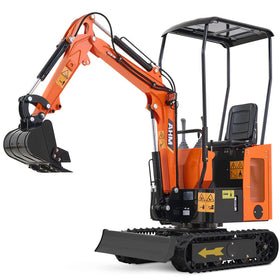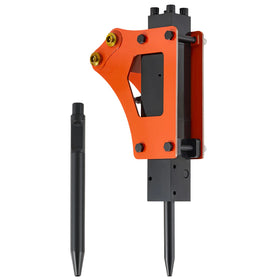Moving and planting trees takes the right equipment to get the job done. Hand tools work fine for small trees. However, if you want to tackle bigger projects, plant multiple trees, and get spectacular results, you need the right equipment. The tree digging blade attachment offers precise control, protecting fragile root systems as you dig. It's especially valuable when handling bigger trees or multiple plantings in a single project. Let's discuss how to transplant your tree successfully with a mini excavator, along with proven tips for outstanding results.

1. Critical Factors for Successful Tree Planting
Tree size directly influences planting depth and root ball requirements. A common mistake is planting too deep, which can suffocate roots and stress the tree. The general rule is to plant at the same depth as the tree grew in its original location, with the root flare slightly above ground level. This precision in depth control becomes essential when handling multiple plantings.
Different soil conditions present unique challenges. From loose soil to permafrost layers and even soft rocks, each type requires specific handling to preserve root structure. Traditional shovels often struggle to maintain consistent depth and clean cuts, especially in harder soils where root damage becomes more likely.
Root System Preservation
The health of the root system often determines transplanting success. When moving established trees, maintaining an adequate root ball is crucial. The size of the root ball should increase proportionally with the tree's trunk diameter. This natural growth pattern requires tools designed to follow the spherical shape of root systems, ensuring more successful transplants. A Kubota mini excavator equipped with a properly sized tree digging blade can carefully extract the root ball while preserving its essential structure.
2. How Tree Digging Blades Support Proper Tree Planting
The right equipment transforms precise tree planting requirements from challenging demands into achievable standards. A mini excavator fitted with a tree digging blade offers controlled depth and consistent hole sizing - two critical factors that directly impact tree survival rates.
When digging with this attachment, the blade's curved design follows the natural growth pattern of root systems. This matters because root balls need different diameters based on tree size. For instance, a 2-inch diameter tree typically needs a root ball at least 24 inches wide, while a 4-inch diameter tree requires a 42-inch root ball. Using a micro excavator with the right blade size helps maintain these proportions consistently.

Soil preparation extends beyond just digging holes. Different soil types, from clay to sandy loam, require different handling approaches. A small excavator can break up compacted soil layers without creating glazed sides in your planting holes - a common issue with manual digging that can trap roots and limit growth. This capability proves especially valuable in harder soils where traditional methods might damage root structures.
3. Step-by-Step Process for Successful Tree Transplanting
Start by assessing your tree's size and calculating the required root ball diameter. This measurement guides your equipment choice - from compact mini diggers for smaller specimens to full-sized excavators for mature trees. Mark your digging area with this measurement in mind.
Before starting excavation, prepare your new planting location first. This reduces the time your tree spends out of the ground. Your hole should be wide enough to accommodate the root ball plus additional space for new root growth, but only as deep as the root ball itself. A mini excavator's precise depth control helps maintain this crucial balance.
3.1. Site Preparation
- Calculate required root ball diameter
- Mark your digging area
- Prepare the new planting location first
- Ensure proper drainage
3.2. Excavation
- Position equipment on level ground
- Maintain vertical blade position
- Work systematically around the root ball
- Keep consistent depth throughout
3.3. Transplanting
- Minimize time between digging and replanting
- Create a hole wider than the root ball
- Match original planting depth
- Allow space for new root growth
4. Equipment Selection for Tree Projects
Matching your excavator to your tree size ensures efficient, safe transplanting. For seedlings and young trees up to 3 inches in diameter, a compact mini excavator provides the ideal balance of power and precision. These machines can maneuver in tight spaces while still delivering the control needed for careful root ball extraction.
Larger trees demand more consideration of root ball weight and size. A standard mini excavator, like the AHM models, typically handles trees up to 6 inches in diameter effectively. The key is choosing a machine with enough lifting capacity to manage your root ball size safely - remember that soil adds significant weight to your load.
Soil conditions influence equipment effectiveness as much as tree size does. In loose, sandy soils, a micro excavator with a smaller blade often provides sufficient force. However, clay or compacted soils may require a more powerful small excavator to maintain clean cuts around the root ball without tearing.
Mini Excavator Size Guide
- Seedlings to 3-inch diameter trees: Compact mini excavator
- Trees up to 6-inch diameter: Standard mini excavator
- Consider root ball weight when selecting equipment
Soil Considerations
- Sandy soil: Smaller blade sufficient
- Clay or compacted soil: More powerful excavator needed
- Adjust technique based on soil moisture
5. Practical Tips for Operation
Position your excavator on solid, level ground before beginning excavation. Start your cut at the calculated root ball diameter, keeping your blade vertical. Work gradually around the root ball, maintaining consistent depth. This methodical approach preserves more fine roots - essential for tree survival after transplanting.
Watch your timing - transplanting success rates improve significantly during dormant seasons when soil moisture levels are moderate. Early spring and fall typically offer ideal conditions, though this varies by region and species. Even with the right equipment, attempting to move trees during peak growth periods or extreme weather conditions risks transplant shock.

6. Long-Term Benefits of Proper Equipment Use
Successful tree transplanting goes beyond just moving trees from one location to another. Using the right mini excavator with a proper tree digging blade attachment significantly impacts both immediate survival rates and long-term tree health. When roots remain intact and soil structure is preserved, trees establish themselves faster in their new locations.
The efficiency gains become particularly apparent in larger projects. Whether you're managing an orchard development or handling multiple transplants, consistent hole depth and proper root ball extraction make a measurable difference in project timelines. A mini excavator setup that matches your project's scale turns days of manual labor into hours of precise work.
Key Points to Remember:
- Match your excavator size to your tree size and soil conditions
- Calculate root ball size based on trunk diameter before selecting equipment
- Time your transplanting during dormant seasons for best results
- Ensure adequate site preparation before beginning excavation
- Maintain consistent depth and vertical cuts for root preservation
The investment in proper equipment pays dividends through higher survival rates and healthier trees. Whether you're working with delicate seedlings or established trees, the right combination of mini excavator and tree digging blade transforms challenging transplants into manageable projects.
FAQ
How should I prepare the ground and soil before planting?
Ensure the area is level and free of hazards, with soil that is damp but not waterlogged. Clear debris and obstacles around the planting spot, and avoid overly compacted soil. If soil is very soft or heavy clay, adjust the tool depth and support to protect the root ball during handling.
How do I choose the right machine and attachments?
Selection depends on tree size, root ball weight, and site constraints. For small trees (root ball roughly 3 inches diameter or smaller), a compact mini excavator is usually sufficient. For root balls approaching 6 inches, verify that the machine’s lifting capacity matches the load and that a suitable attachment (e.g., a gentle clamshell or bucket with padding) is used to protect roots. Always follow the manufacturer’s loading charts and safety guidelines.
When is the best time to transplant trees?
In many regions, early spring or fall (dormant seasons) are ideal because the tree can establish roots before extreme heat or cold. Local climate and species-specific needs vary, so check regional guidance or consult a local nursery for timing tailored to your area.
What safety precautions should be followed?
Ensure operators are trained and wearing PPE (helmet, safety glasses, gloves, steel-toed boots). Keep bystanders clear, identify buried utilities, and avoid working near unstable ground. Move slowly, test stability often, and avoid jerky movements that can damage roots or tip the machine.
What if the root ball gets damaged during handling?
Minimize further disturbance to the root ball, keep soil intact around roots, and provide immediate irrigation after planting. If extensive root damage occurs, reassess site location or consider using a smaller root ball or more resilient tree variant. Professional consultation is recommended for significant damage.
Can I plant by hand instead of using a mini excavator?
Hand planting is feasible for very small root balls or where machinery can’t access the site, but it’s more labor-intensive and carries higher risk of root damage for larger trees. If choosing manual methods, proceed with careful digging, root preservation, and proper backfilling and watering.







